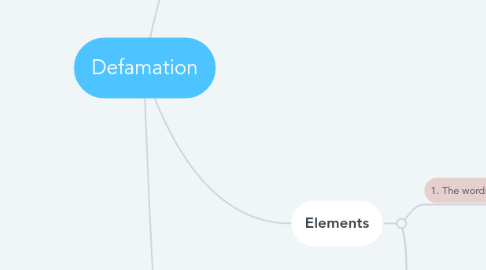
1. Types
1.1. Libel
1.1.1. Permanent form and is usually visible to the eye, such as items in writing which include e-mail, pictures, statues or effigies. It is actionable per se, which means that a P need not prove any damage.
1.1.1.1. Bitutech Sdn Bhd v Bosco Philip Anthony & Ors
1.2. Slander
1.2.1. Temporary or transient form. Publication is usually made through spoken words or gestures. Slander is not actionable per se. The P therefore needs to prove actual or special damage in order to succeed in his action.
1.2.1.1. Exceptions
1.2.1.1.1. 1. Slander to women
1.2.1.1.2. 2. Slander in relation to a person's professional or business reputation
1.2.1.1.3. 3. Slander in relation to title, slander of goods and malicious falsehood
1.2.1.1.4. 4. Imputation of a contagious disease
1.2.1.1.5. 5. Imputation of a crime
2. Elements
2.1. 1. The words are defamatory
2.1.1. Natural and ordinary meaning
2.1.1.1. Institute of Commercial Management United Kingdom v New Straits Time Press (Malaysia) Bhd
2.1.1.1.1. F: The P claimed damages against the D for libel in respect of words contained in an article published by the D entitled 'British' diploma mills step up sales racket'. The P alleged that the words in the article in their natural and ordinary meaning or by innuendo were understood to mean, inter alia, that the P was one of the 'diploma mills' advertising actively in Malaysia, that the P was carrying out unlawful activities in Malaysia and other places.
2.1.1.1.2. H: Ordinary reasonable person reading the article would link ICM with one of those organisations which operated the 'diploma mill's. The words had a strong tendency to lower the plaintiff in the estimation of right-thinking members of society generally or the parents of potential students or the potential students themselves.
2.1.2. Innuendo
2.1.2.1. i. False innuendo
2.1.2.1.1. Syed Husin Ali v Sharikat Penchetakan Utusan Melyu Sdn Bhd
2.1.2.2. ii. True or legal innuendo
2.1.2.2.1. Tolley v Fry & Sons Ltd
2.1.3. Juxtaposition
2.1.3.1. Monsoon v Tussauds
2.2. 2. The words refer to the plaintiff
2.2.1. David Syme v Canavan
2.3. 3. The words have been published
2.3.1. Dr Jenni Ibrahim v S Pakianathan
3. Defences
3.1. Consent or Assent and Volenti Non Fit Injuria
3.1.1. Cookson v Harewood
3.2. Justification
3.2.1. S Pakianathan v Dr Jenni Ibrahim
3.3. Fair Comment
3.3.1. i. The words must be in the form of comment and not a statement of fact
3.3.1.1. Jb Jeyaretnam v Goh Chok Tong
3.3.2. ii. The comment must be based on true facts
3.3.2.1. Telnikoff v Matusevitch
3.3.3. iii. The comment is fair and not malicious
3.3.4. iv. The comment concerns an issue of public interest or importance
3.3.4.1. London Artist Ltd v Littler
3.4. Privileges
3.4.1. Types
3.4.1.1. Statutory qualified privilege
3.4.1.2. Common law qualified privilege
3.4.1.2.1. Four recognised circumstances of privileged occasions
3.5. Unintentional Defamation
3.5.1. Sandison v Malayan Times Ltd & Ors
3.6. Immunity
3.6.1. Dato' Param Cumaraswamy v MBF Capital Bhd
3.7. Apology
3.7.1. Keluarga Communication v Normala Samsudin
3.8. Mitigation of Damages
3.9. Factors Taken Into Account in Assessing Damages
3.9.1. Tan Sri Dato' Vincent Tan Chee Yioun v Haji Hasan bin Hamzah & Ors
